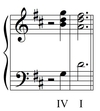8 - Rhythm - Simple, Compound & Hybrid Time Flashcards
Use this deck to learn Rhythm in Simple, Compound and Hybrid Time, review cadences, chords, scales and intervals. Audio is included to supplement your learning. Master Your Musicianship Skills - Complete Lesson 8 of the matching Ultimate Music Theory Advanced Workbook to enhance your music theory training. UltimateMusicTheory.com (169 cards)
Identify the Time Signature as Simple, Compound or Hybrid Time.

Compound Time

Identify the Time Signature as Simple, Compound or Hybrid Time.

Simple Time

Identify the Time Signature as Simple, Compound or Hybrid Time.

Hybrid Time

Identify the Time Signature as Simple, Compound or Hybrid Time.

Compound Time

Identify the Time Signature as Simple, Compound or Hybrid Time.

Simple Time

Identify the Time Signature as Simple, Compound or Hybrid Time.

Hybrid Time

Identify the Time Signature as Simple, Compound or Hybrid Time.

Hybrid Time

Identify the Time Signature as Simple, Compound or Hybrid Time.

Compound Time

Identify the Time Signature as Simple, Compound or Hybrid Time.

Compound Time

Identify the Time Signature as Simple, Compound or Hybrid Time.

Hybrid Time

Identify the Time Signature as Simple, Compound or Hybrid Time.

Simple Time

Identify the Time Signature as Simple, Compound or Hybrid Time.

Hybrid Time

Identify the Time Signature as Simple, Compound or Hybrid Time.

Hybrid Time

Identify the Time Signature as Simple, Compound or Hybrid Time.

Simple Time

Identify the missing Time Signature.

The Time Signature is

Identify the missing Time Signature.

The Time Signature is

Identify the missing Time Signature.

The Time Signature is

Identify the missing Time Signature.

The Time Signature is

Identify the missing Time Signature.

The Time Signature is

Identify the missing Time Signature.

The Time Signature is

Identify the missing Time Signature.

The Time Signature is

Identify the missing Time Signature.

The Time Signature is

Identify the missing Time Signature.

The Time Signature is

Identify the missing Time Signature.

The Time Signature is





















































































































































































































































